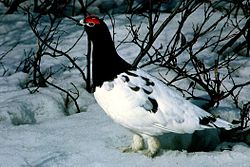Ptarmigan
|
Lagopus Temporal range: Early Pliocene to present |
|
|---|---|
 |
|
| Willow ptarmigan (L. lagopus) | |
| Scientific classification | |
| Kingdom: | Animalia |
| Phylum: | Chordata |
| Class: | Aves |
| Order: | Galliformes |
| Family: | Phasianidae |
| Subfamily: | Tetraoninae |
| Genus: |
Lagopus Brisson, 1760 |
| Species | |
|
See text |
|
See text
Lagopus is a small genus of birds in the grouse subfamily, commonly known as ptarmigans. The genus contains three living species with numerous described subspecies, all living in tundra or cold upland areas.
The genus name Lagopus is derived from Ancient Greek lagos (λαγος), meaning "hare", + pous (πους), "foot", in reference to the feathered feet and toes typical of this cold-adapted group (such as the snowshoe hare). The specific epithets muta and leucura were for a long time misspelt mutus and leucurus, in the erroneous belief that the ending of Lagopus denotes masculine gender. However, as the Ancient Greek term λαγωπους is of feminine gender, and the specific epithet has to agree with that, the feminine muta and leucura are correct.
The English-language name ptarmigan is derived from the Scottish Gaelic tàrmachan.
The three species are all sedentary specialists of cold regions. Willow ptarmigan is a circumpolar boreal forest species, white-tailed ptarmigan is a North American alpine bird, and rock ptarmigan breeds in both Arctic and mountain habitats across Eurasia and North America. All, with the exception of the red grouse, have a white winter plumage that helps them blend into the snowy background. Even their remiges are white, while these feathers are black in almost all birds (even birds that are predominantly white, such as the Bali myna) because melanin makes them more resilient and thus improves flight performance. The Lagopus grouse apparently found it easier to escape predators by not being seen than by flying away.
...
Wikipedia
